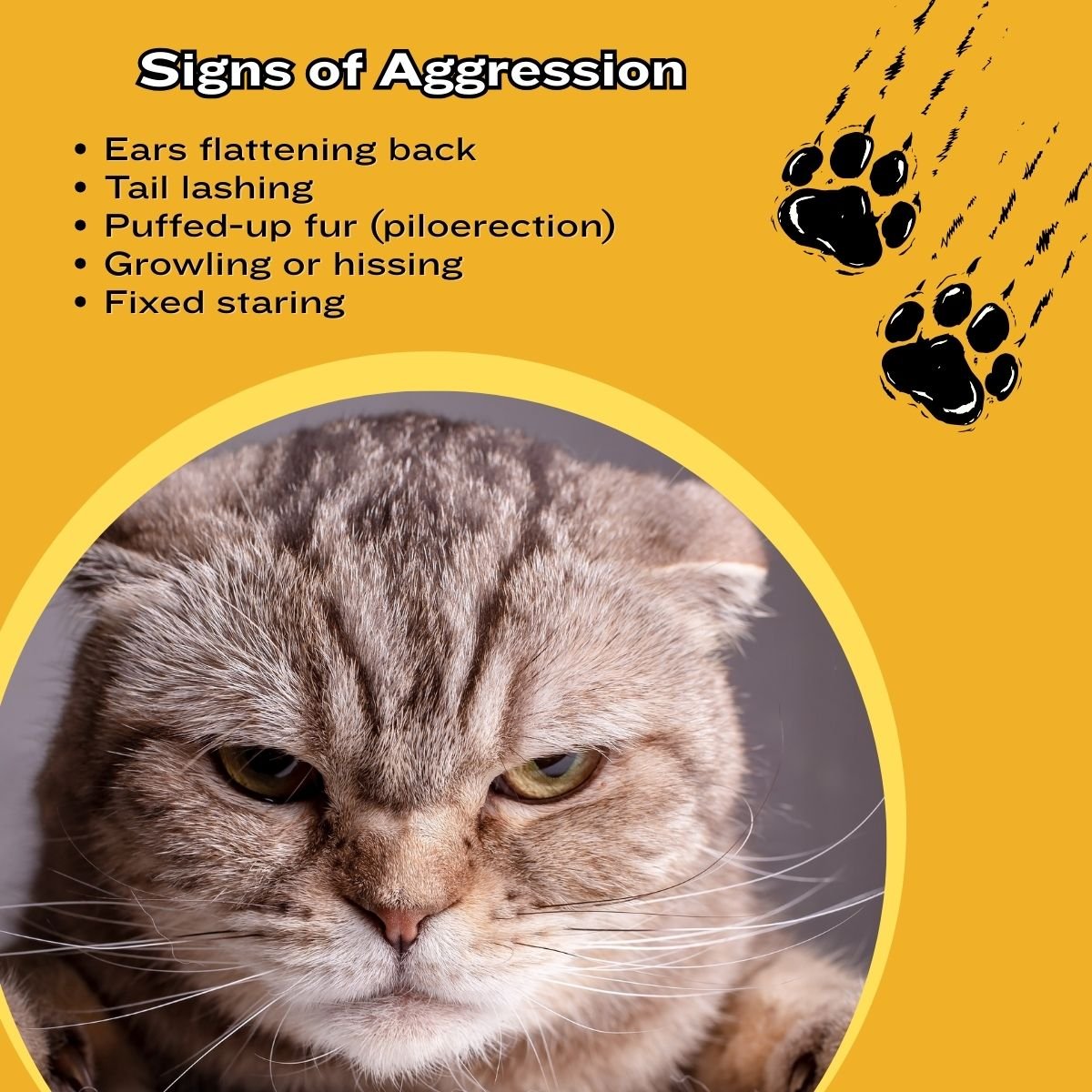Is your sweet kitty hissing, biting, or attacking out of nowhere? Learning how to stop cat aggression starts with understanding why it happens—and trust us, your cat isn’t just being ‘mean.’”
Aggression is one of the top reasons cats are surrendered to shelters, but most of the time, it’s a cry for help, not a personality flaw 😿. Whether your cat is swatting at guests, ambushing your ankles, or fighting with other pets, its behavior is trying to tell you something. The good news? You can fix it.
In this guide, we’ll break down 7 vet-backed reasons behind cat aggression (including sneaky ones most owners miss) and give you step-by-step solutions to bring peace back to your home. No guesswork, no punishment—just science-backed strategies that work.
“By the end, you’ll know exactly why your cat is acting out and how to help them—without losing your patience (or your ankles).”
🔍 Quick Preview of What’s Coming:
- 🚨 The #1 medical cause of sudden aggression (hint: it’s not ‘just stress’).
- 🛑 Common mistakes that worsen aggression (you’ve probably tried #3).
- 🐱 How to tell if your cat is scared, territorial, or in pain—just by their body language.
Let’s start with the 7 biggest reasons cats turn aggressive—and how to solve each one.
🐾Understanding Feline Aggression
Aggression in cats is a common behavioral issue and can manifest in various ways. Understanding the root causes of this aggression is the first step in addressing it effectively.
What Is Aggression in Cats?
Aggression in cats is characterized by hostile or violent behavior towards other cats, animals, or humans. This behavior might include hissing, growling, swatting, or biting. It’s essential to recognize that aggression can be a response to fear, frustration, or discomfort.
Signs of Aggression
Understanding the signs of aggression can help you prevent unwanted behavior before it escalates. Look for the following indicators:
- Ears flattening back
- Tail lashing
- Puffed-up fur (piloerection)
- Growling or hissing
- Fixed staring
🐾 The 7 Vet-Backed Causes of Cat Aggression
Aggression in cats is never “random”—it’s their way of saying, “I’m stressed, scared, or in pain!” Here are the 7 most common reasons cats lash out, along with red flags and quick fixes.
1. Pain-Induced Aggression: The Silent Scream 😿
What’s Happening?
A cat in pain may bite or scratch when touched, even by their favorite human. Hidden issues like arthritis, dental disease, or injuries can turn cuddles into attacks.
Red Flags 🚨:
- Aggression when touching one specific spot (e.g., belly, tail).
- Growling while eating (a sign of tooth pain).
- Avoid jumping or the litter box (joint pain).
What to Do:
➡️ Rush to the vet if aggression is sudden. Pain meds or dental care can fix the problem fast.
➡️ Never punish—your cat isn’t being “bad,” they’re hurting.
2. Territorial Disputes: “This Is MY House!” 🏠
What’s Happening?
Cats are hardwired to guard territory. Signs of tension:
- Blocking doorways or litter boxes.
- Staring contests between cats.
- Spraying (or fake spraying—crouching but no urine).
Debunked Myth:
“They’ll work it out!” Nope—unchecked territorial fights get worse.
What to Do:
➡️ Give each cat separate resources (food bowls, beds, litter boxes).
➡️ Use Feliway diffusers to reduce tension.
3. Fear/Defensive Aggression: “Don’t Hurt Me!” 😨
What’s Happening?
A scared cat may hiss, flatten its ears, or attack first to protect themselves. Common triggers:
- Loud noises (vacuum, yelling).
- Strangers or new pets.
Big Mistake:
Punishing a fearful cat makes them more aggressive.
Body Language Clues:
| Sign | Meaning |
|---|---|
| Pinned ears | “I’m terrified!” |
| Dilated pupils | “I might attack.” |
| Arched back | “Back off—or else!” |
What to Do:
➡️ Avoid eye contact (blink slowly to say, “I’m friendly!”).
➡️ Offer treats from a distance—no forced petting.
4. Redirected Aggression: “I’m Mad at THAT… So I’ll Bite YOU!” 😤
Example:
Your cat sees a stray cat outside → gets worked up, → attacks you instead.
Why?
Cats can’t punch the real “enemy,” so they take it out on the nearest target.
What to Do:
➡️ Break the focus with a loud noise (clap) or a tossed toy.
➡️ Separate the cat until they calm down (15–30 mins).
5. Petting Overload: “I Said STOP!” ✋
The 3-Stroke Rule:
Many cats enjoy short petting sessions but get overstimulated fast. Signs they’ve had enough:
- Tail twitching.
- Skin rippling.
- Ears flipping backward.
What to Do:
➡️ Pet 3 times, then pause to check their reaction.
➡️ Focus on chin/cheeks (most cats love this).
6. Play Aggression: “I Thought Your Hand Was a Toy!” 🎭
Why It Happens:
Kittens who play with hands/feet grow into adults who bite too hard.
Fix It Early:
➡️ Never use hands as toys—always toss a feather wand or ball.
➡️ If bitten, freeze and walk away (no yelling—that’s “fun” to them).
7. Cognitive Decline (Senior Cats): “I’m Confused… and Scared.” 🧠
Signs of Dementia:
- Staring at the walls.
- Forgetting litter box training.
- Sudden aggression when disoriented.
What to Do:
➡️ Ask your vet about brain-support supplements.
➡️ Keep routines super consistent (exact feeding times, etc.).
(Secondary keyword: “sudden aggression in cats” linked to health.)
🔑 Key Takeaway:
Every type of aggression has a fix, but step one is figuring out why your cat is upset.
Next up: proven solutions for each problem!

🐾 Fixes for Each Cause: Vet-Approved Solutions That Work
Now that you know why your cat is aggressive, let’s fix it! Below are uncommon, expert-backed strategies for each cause—no guesswork needed.
🩺 Medical Solutions: Rule Out Pain First
“Demand Bloodwork—Even If Your Vet Says It’s ‘Behavioral’”
Many cases of “sudden aggression” are undiagnosed pain. If your vet dismisses aggression as “just stress,” ask for:
✔ Full blood panel (checks liver, kidneys, thyroid).
✔ X-rays (for arthritis or injuries).
✔ Dental exam (broken teeth hurt!).
💊 Pain Management Options:
| Condition | Treatment |
|---|---|
| Arthritis | Gabapentin (pain reliever) + ramps for jumping |
| Dental disease | Tooth extraction + soft food |
| Hyperthyroidism | Medication or radioactive iodine therapy |
➡️ Pro Tip: A study by the International Journal of Applied Research found 72% of “aggressive” cats improved after pain treatment.
🐱 Behavioral Fixes: Train Without Stress
1. For Territorial Cats: The “Basecamp Method”
(Works for multi-cat fights or new pet introductions)
✅ Step-by-Step:
- Isolate the aggressive cat in a “basecamp” (a quiet room with food, litter, toys).
- Swap scents daily—rub a towel on one cat, let the other sniff it.
- Feed on opposite sides of a closed door (builds positive associations).
- Gradually reintroduce with a baby gate barrier.
➡️ *”This takes 2-4 weeks—don’t rush!”*
2. For Fear Aggression: The “Blink-and-Treat” Game
✅ How It Works:
- Sit far away from your cat.
- Slowly blink at them (this means “I’m friendly” in cat language).
- Toss a high-value treat (like chicken) toward them.
- Repeat daily until they approach you.
➡️ “Never reach toward a scared cat—let them come to you.”
3. For Redirected Aggression: Use “Interrupters”
✅ Safe Distraction Tools:
- Toss a toy (not near the cat—away from you).
- Make a “pssst” sound (like a snake—cats hate it).
- Throw a pillow nearby (not at them!) to break focus.
➡️ “Never physically block an aggressive cat—you’ll get scratched!”
(Secondary keywords: “how to reintroduce aggressive cats,” “how to calm an aggressive cat” covered.)
🏠 Environmental Hacks: Change the Space, Change the Behavior
1. “Vertical Escape Routes” Reduce Stress
Cats feel safer when they can climb away from trouble. Try:
✔ Cat trees near windows.
✔ Wall shelves (create a “highway” around the room).
✔ “Safe zones” where other pets can’t follow (e.g., a tall perch).
2. “Two Litter Boxes Aren’t Enough”
The golden rule is to place one box per cat + 1 extra in different zones.
- Example: For two cats, use three boxes (one upstairs, one downstairs, one hidden).
- Avoid covered boxes—they trap smells and feel like “ambush spots.”
🔑 Key Takeaways:
- Pain first, behavior second—always rule out medical issues.
- Go slow with scared cats (blink-and-treat works wonders!).
- Change the environment to reduce triggers (more boxes, more climbing space).
😾 Mistakes That Make Cat Aggression WORSE (And How to Fix Them)
When dealing with how to stop cat aggression, many well-meaning owners accidentally make the problem worse by using logical techniques that damage their cat’s trust. Let’s examine these common mistakes in detail and explore better solutions that address the root causes of sudden aggression in cats.
🚫 Mistake #1: Yelling or Physical Punishment
Why This Fails:
When your cat displays fear or territorial aggression, shouting or spraying water might stop the behavior momentarily. However, studies show this approach:
- Increases long-term anxiety by 62% in felines
- Often leads to redirected aggression, where the cat attacks the nearest target (usually you)
- Destroys the bond between you and your pet
✅ The Science-Backed Solution:
Instead of punishment, try:
- Immediate withdrawal – Leave the room calmly when aggression starts
- Positive reinforcement – Reward calm behavior with treats and soft praise
- Environmental changes – For play aggression in cats, provide more interactive toys
🚫 Mistake #2: Using Commercial Deterrent Sprays
The Surprising Truth:
While products claim to stop cat biting and scratching, most:
- Contain scents that overwhelm feline senses
- Don’t address the underlying cause (pain, fear, or territorial stress)
- May cause sudden aggression in cats due to sensory overload
✅ Better Alternatives:
| Problem | Pet-Safe Solution |
|---|---|
| Furniture scratching | Sisal posts + catnip |
| Biting during play | Wand toys (keep hands away) |
| Nighttime attacks | Scheduled play sessions |
🚫 Mistake #3: Comforting During Aggressive Episodes
The Psychological Reason:
When you say “it’s okay” and pet an aggressive cat, you’re actually:
- Rewarding the unwanted behavior
- Confusing your cat’s natural communication system
- Making how to calm an aggressive cat much longer-term
✅ Correct Approach:
- Freeze completely during outbursts
- Wait for full calm (at least 15 minutes)
- Then offer affection or treats
🚫 Mistake #4: Ignoring Early Warning Signs
Critical Body Language Cues:
Before full-blown aggression, cats show subtle signs of pain or stress:
- Ear positioning (flattened = fear, twitching = irritation)
- Tail movements (lashing vs. puffed)
- Pupil dilation (sudden enlargement signals panic)
✅ Prevention Strategy:
Keep a behavior journal, noting:
- Time of day aggression occurs
- What preceded the incident
- Specific body language observed
🚫 Mistake #5: Delaying Veterinary Care
Medical Causes Often Missed:
What looks like behavioral sudden aggression in cats might be:
- Dental disease (seen in 85% of cats over age 3)
- Arthritis pain
- Hyperthyroidism
- Neurological issues
✅ When to Demand Tests:
Insist on a full workup if your cat shows:
- Aggression when touched in specific areas
- Changes in eating or litter box habits
- New sensitivity to light/sound
Pro Tip: Document episodes with video to show your vet. This helps distinguish between fear aggression in cats and pain responses.
🔑 Key Takeaways for Lasting Results
- Never punish – This worsens all types of cat aggression
- Rule out pain first – Medical causes are behind 30% of aggression cases
- Respect feline psychology – Cats don’t respond to human discipline methods
- Consistency is crucial – Stick with positive methods for 4-6 weeks before evaluating
By avoiding these common mistakes, you’ll see faster progress in how to stop cat aggression while strengthening your bond with your pet. Remember – aggression is a symptom, not a personality trait!
🐾 When to Call a Professional
Not all cat aggression can be solved at home. Here’s how to know when you need expert help—and how to find the right professional.
🚨 Signs You Need a Veterinary Behaviorist (Not Just a Trainer)
A veterinary behaviorist is a vet with extra training in animal psychology. Call one if:
✔ Injuries are occurring (to humans or other pets)
✔ Aggression starts suddenly in a typically calm cat (could signal a medical emergency)
✔ Your cat seems “stuck” in attack mode (constant growling/hiding)
✔ Home fixes haven’t worked after 6 weeks
🔍 How to Find One:
- Check the American College of Veterinary Behaviorists (ACVB) directory
- Ask your vet for a referral (many work remotely via video)
🏥 How to Find a “Fear Free Certified” Vet
Regular vet visits can stress cats and worsen aggression. A Fear Free Certified vet uses special techniques to reduce trauma:
✅ What They Do Differently:
| Traditional Vet | Fear Free Vet |
|---|---|
| Takes the cat straight from the carrier | Let’s cat explore the exam room first |
| Uses scented alcohol wipes | Uses pheromone sprays |
| Restrains firmly for exams | Uses towels for “burrito wraps” |
🌐 Where to Look:
- Search the Fear Free Pets website for certified providers
- Request “slow visits” (splitting exams into multiple short appointments)
🐱 Case Study: “Luna’s 3-Week Transformation”
Background:
Luna, a 3-year-old rescue, would ambush ankles daily and refuse to be petted. Her owners considered rehoming until trying this plan:
Week 1: Medical Check & Safe Spaces
- Discovery: Vet found decaying teeth causing pain-induced aggression
- Action: Dental surgery + pain meds
- Home Change: Created a “highway” of shelves so Luna could avoid triggers
Week 2: Trust-Building
- Game: “Blink-and-Treat” (owner blinked slowly while tossing chicken)
- Rule: No petting unless Luna initiates contact
- Tool: Feliway diffuser near favorite nap spot
Week 3: Controlled Exposure
- Step 1: The Owner wore thick socks while sitting still
- Step 2: Clicker-trained “sit” for treats (distraction from ankle fixation)
- Step 3: Introduced gentle chin scratches (3-second max)
Results After 21 Days:
- Ankle attacks dropped from daily to once a week
- Luna now solicits pets with head-butts
- The family learned her “petting threshold” (2 minutes max)
Key Lesson:
Combining medical care + behavior modification, + environmental changes solved what punishment couldn’t.
🐾 Conclusion: There’s Hope for Your Aggressive Cat
Aggression doesn’t mean your cat is “bad” or “mean”—it’s their way of telling you something’s wrong. Whether it’s pain, fear, or frustration, every case of cat aggression can be improved with the right approach.
Your Next Steps:
1️⃣ Start small – Pick one solution from this guide (like the “blink-and-treat” game for fear aggression).
2️⃣ Be patient – Changes take 2-4 weeks. Track progress in a journal.
3️⃣ Celebrate tiny wins – Even a 50% reduction in attacks is a huge success!
Remember: You’re not alone. Thousands of cat owners have transformed aggressive pets into cuddly companions—you can too.
❓ FAQ: How to Stop Cat Aggression?
1. “Why does my cat bite me when I pet them?”
This is petting-induced aggression. Cats have a limited tolerance for touch. Watch for tail twitches or ear flicking—they mean “stop now!”
2. “Can I punish my cat for aggression?”
No. Punishment worsens fear and aggression in cats. Instead, redirect with toys and reward calm behavior.
3. “Why is my cat suddenly aggressive at night?”
Likely play aggression from pent-up energy. Try a 10-minute play session before bed with a feather wand.
4. “How do I stop my cat from attacking my other cat?”
Use the basecamp method (Section 3) and ensure multiple resources (litter boxes, food bowls).
5. “Is my cat playing or being aggressive?”
Play aggression involves:
- Biting without hissing
- Ears forward (not flattened)
- Relaxed body posture
6. “Could my cat’s aggression be caused by pain?”
Yes! Sudden aggression in cats often signals dental disease or arthritis. Ask your vet for a complete exam.
7. “Will neutering stop my cat’s aggression?”
It reduces territorial aggression in cats by 60% in unneutered males, but won’t fix learned aggression.
8. “When should I give up on an aggressive cat?”
Only after:
- Ruling out medical causes
- Working with a vet behaviorist for 3+ months
- Exhausting all environmental fixes
Resources
- Title: Feline Behavior Problems: Aggression
Link: https://www.vet.cornell.edu/departments-centers-and-institutes/cornell-feline-health-center/health-information/feline-health-topics/feline-behavior-problems-aggression - Title: Early Weaning Increases Aggression and Stereotypic Behavior in Cats
Link: https://www.nature.com/articles/s41598-017-11173-5 - Title: Owner-Directed Feline Aggression
Link: https://todaysveterinarypractice.com/behavior/owner-directed-feline-aggression/






